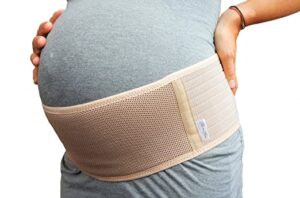Diastasis recti, or rectus abdominis diastasis, is when a gap of 3 cm or greater forms between the two sides of the rectus abdominis muscle. The distance between the right and left rectus abdominis muscles is created by the stretching of the connective tissue between them called the ‘linea alba’.
Symptoms:
-
There might be a noticeable bulge in the middle of the abdomen (especially when sitting up from a lying down position).
-
The abdomen area is usually pain free but can cause low back pain, upper back pain and pelvic girdle pains.
-
Diastases Recti is also sometimes associated with bloating and constipation.
-
Softness or jelly-like feeling around your belly button.
-
Pain during sex.
-
Poor posture.
-
Urine leaking when you sneeze or cough.
-
Feeling weak in your abdominals.
Causes:
-
The abdomen is made up of two sets of muscles that are separated by a thin band of connective tissue (linea alba) in between. These muscles are pushed outward and stretched to make room for the growing baby. Diastasis recti occurs when the linea alba is overstretched and doesn’t come back together.
-
You are at more risk if you are carrying more than one baby or have had previous pregnancies.
-
Women over the age of 35 are more likely to develop abdominal separation that doesn’t resolve on it’s own.
-
You are more at risk if you deliver a heavier / bigger baby (especially vaginal deliver due to the pushing involved with this.
-
Previous surgeries in the area.
Here is what the evidence says about the treatment options:
Exercise – THIS study found that general exercise in the ante and postnatal periods could help with the appearance (width) of diastasis recti but the evidence available to the researchers wasn’t of the highest quality. THIS study, which was more recent, looked at a specific ‘deep core exercise programme‘ and concluded that it was effective in treating diastasis recti and improving postpartum women’s quality of life. Exercise classes such as Yoga and Pilates will incorporate this kind of exercise, usually starting with the basics to help you tune back in to the correct feelings and positions.
Have a look at our Top 5 online Pilates programmes here and our Top 5 Yoga classes here (and why we love them)! You can also read our blog on how yoga can help in other ways.
Avoidance – It is usually advised that you avoid;
- Heavy lifting.
- Any exercises that involve repetitive twisting of the spine.
- Repetitive abdominal work like
- Crunches, oblique curls, reverse curls, and roll-ups.
- You will be able to reintroduce these exercises (if you wish) but you need guidance on overall strength before introducing this type of exercise back into your regimen.
Surgery – as Physiotherapists we would only recommend any surgical procedures when there are no other options (due to the risks involved with surgery). Evidence on what conservatory treatment to use is still sparse, exercise is supported but no set plan has been recognised as a gold standard. Both open and laparoscopic surgery have shown positive results through research but you would need to speak to your GP about this.
Pregnancy support belt – Support belts during pregnancy can help take some of the pressure off the back, pelvis and growing bump. It is theorised that this can also help to support the abdominal wall, consequently reducing pressure on the abdominal muscles in their every day use.
Support belts should not be seen as a replacement for exercises and strength work but as a welcomed addition. There are very few studies backing-up their use when it comes to DRAM or diastasis recti, this isn’t to say that it doesn’t work, but more research is certainly needed into this area.
Here are our top 5 choices of maternity support belts (here) to help guide you based on what they can help with and what we like about them.
Abdominal support – These are different to maternity support belts as they are used after giving birth only and are to support the stretched abdominal muscles. There is limited research into the use of abdominal support garments when it comes to Diastus Recti but they have been investigated following c-section delivery. THIS study found that the use of a binder following a caesarean delivery, decreased the feeling of distress and increased mobility in the mother. There is no evidence that we have come across which suggests whether one type of binder / wrap works better than another.
Here is a great support garment (abdominal binder) that has really good reviews. There are many different types available and no research to say which works best so look at what suits you and your budget.
Really helpful links we think you’ll love:
A podcast that we would recommend with further information on Diastasis Recti: Abdominal Muscle Separation – Can I fix it? – FitNest Mama
Symptoms to watch out for:
Weakness in the abdominal region can be associated with bladder and bowel issues, lower back pain and prolapse.
If you have any of the following symptoms then go to your nearest accident and emergency department immediately:
-
Severe low back pain.
-
Pain, numbness, or weakness in one or both legs that causes you to stumble or have trouble getting up from a chair.
-
Loss of or altered sensations in your legs, buttocks, inner thighs, feet or areas that you sit on when in a chair (including genitals / anus) that is severe or gets worse and worse.
-
Recent problem with bladder or bowel function, such as trouble eliminating urine or waste (retention) or trouble holding it (incontinence).
-
Sexual dysfunction that has come on suddenly.
Cauda Equina Syndrome is a very rare but very serious condition that must be addressed immediately to prevent any lasting damage to the nerves involved.



